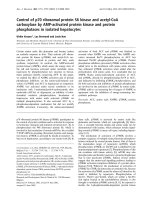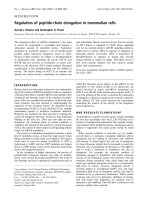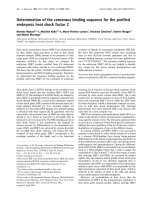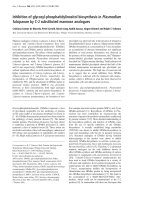Báo cáo y học: " Control of disseminated intravascular coagulation in Klippel-Trenaunay-Weber syndrome using enoxaparin and recombinant activated factor VIIa: a case report" pptx
Bạn đang xem bản rút gọn của tài liệu. Xem và tải ngay bản đầy đủ của tài liệu tại đây (488.29 KB, 4 trang )
CAS E REP O R T Open Access
Control of disseminated intravascular coagulation
in Klippel-Trenaunay-Weber syndrome using
enoxaparin and recombinant activated factor
VIIa: a case report
Ulf H Beier
1
, Mary Lou Schmidt
1
, Howard Hast
2
, Susan Kecskes
2
, Leonard A Valentino
3*
Abstract
Introduction: Vascular malformation is associated with coagulopathies, especially when hemostasis is challenged.
Case presentation: We present the case of an 11-year-old Hispanic girl with Klippel-Trenaunay-Weber syndrome
that developed disseminated intravascular coagulation after minor surgery, which was controlled by blood product
transfusions and enoxaparin to address an ongoing consumptive coagulopathy. The patient, however, developed
bacteremia and liver trauma that resulted in severe bleeding. To the best of our knowledge, we report here the
first known instance of administering recombinant coagulation facto r VIIa to control acute bleeding in a patient
with Klippel-Trenaunay-Weber syndrome.
Conclusions: This case illustrates the concept of enoxaparin maintenance to suppress an ongoing consumptive
coagulopathy and the use of recombinant coagulation factor VIIa to control its potentially fatal severe bleeding
episodes.
Introduction
Vascular malformations are associated with coagulopa-
thies, especially in patients challenged by the stress of
surgery [1,2]. A major problem previously associated
with the condition is inaccurate diagnostic classification,
as many of these vascular abnormalities require different
methods of treatment [3,4]. There are two principal
categories of vascular abnormalities associated with
bleeding. One category includes those which arise sec-
ondary to cellular proliferation like the Kasabach-Merritt
syndrome (KMS) with predominant platelet trapping,
while the other includes thoseinwhichtheetiologyis
based upon the distortion of the vascular bed, which
leads to continuous activation and subsequent consump-
tion of clotting factors [4,5].
Meanwhile, the Klippel-Trenaunay syndrome is a triad
of port-wine stain s, varicose veins, and osseous or soft
tissue hypertrophy involving one or multiple extremities.
When combined with arteriovenous malformations, the
syndrome develops into the Klippel-Trenaunay-Weber
syndrome (KTWS), a condition that can be associated
with both KMS and consumptive coagulopathy [6,7].
Case presentation
An 11-year-old Hispanic girl with previously diagnosed
KTWS and numerous vascular abnormalities in her lower
extremities was transferred from an outside hospital three
days after the resection of a valvular capillary heman-
gioma. A physical examination and a computed tomogra-
phy (CT) scan confirmed the presence of KTWS by
showing diffuse hemangiomas, varicosities, and arteriove-
nous malformations involving the soft tissues of the pelvis
and the bilateral lower extremities that had caused bilat-
eral lower limb hypertrophy, mostly on the right limb.
There was massive postoperative bleeding from the
wound with an estimated blood loss of 14.7 ml/kg in
the first five hours after the procedure. Disseminated
intravascular coagulation (DIC) ensued with increased
D-dimers and low levels of fibrinogen (95 mg/dl). The
patient was transfused with 15 ml/kg of packed red
* Correspondence:
3
The RUSH Hemophilia and Thrombophilia Center, Department of Pediatrics,
Rush Children’s Hospital and Rush University Medical Center, Chicago, Illinois,
USA
Beier et al. Journal of Medical Case Reports 2010, 4:92
/>JOURNAL OF MEDICAL
CASE REPORTS
© 2010 Beier et al ; licensee BioMed Central Ltd. This is an Open Access article distributed und er the terms of the Creative Commons
Attribution License ( whi ch permits unrestr icted use, distribut ion, and reproduction in
any me dium, provided the original work is properly cited.
blood cells one day after the operation. Hemostasis was
eventually achieved at 13 days after the operation. How-
ever, due to ongoing DIC, daily transfusions with packed
red blood cells, platelets, cryoprecipitate, and fresh fro-
zen plasma were required.
Following the criteria set by Mazoyer et al. [4], we
considered a condition of consumptive coagulopathy
secondary to venous malformations. A therapy of low-
molecular-weight heparin (LMWH) (enoxaparin, 1 mg/kg
once daily) was therefore begun on day 29. The bleeding
abated abruptly, hence transfusions of blood products
were no longer needed (Figure 1). The bleeding was
controlled until the patient became febrile and bactere-
mic at 38 days after the operation.
TriggeredbybacteremiawithCitrobacter youngae and
Enterococcus faecalis, DIC recurred and bleedi ng
resumed 4 0 days after the operation with up to 53 ml/kg
of blood replacements per day. Enoxaparin was discon-
tinued and aminocaproic acid (100 mg/kg) was adminis-
tered to limit fibrinolysis. The bleeding subsided on the
following day . When the acute bleeding stopped, the
patient’s blood count improved under resumed enoxa-
parin therapy and the patient was no longer in need of
blood product transfusion until day 52.
Figure 1 Postoperative platel et counts, fibrinogen levels, and cryoprecipitate transfusions. The black arrow indicates initiation of
low-molecular-weight heparin (black bars). The white arrow #1 indicates the onset of bacteremia and the white arrow #2 indicates cholecystomy
drainage placement with subsequent liver laceration. The interval of aminocarpoic acid administration is indicated by the dark grey bars. The
initiation (arrow #2) and duration of administration of recombinant activated factor VII is indicated by a light grey bar, while the duration of
unfractionated heparin administration is indicated by a white bar.
Beier et al. Journal of Medical Case Reports 2010, 4:92
/>Page 2 of 4
Meanwhile, the patient had developed choles tasis that
required cholecystostomy drainage on the 53
rd
day fol-
lowing the initial hemangioma surgery. Two days later,
the patient’ s hemoglobin dropped precipitously and
massive ascites d eveloped. This led to elevation of the
patient’s diaphragm and respiratory distress that resulted
in the need for intubation. An exploratory laparotomy
showed a subcapsular tear and hematoma. Enoxaparin
was suspended wh ile numerous transfusions, aminoca-
proic acid and, for th e first time, recom binant activated
factor VII (rFVIIa, NovoSeven®, Novo Nordisk, Den-
mark, 30 μg/kg every 2 hours) were administered to the
patient. The rFVIIa was continued for 12 days, then gra-
dually tapered over an additional 15 days. Subsequently,
the bleeding originating from the hepatic laceration
subsided.
The patient was discontinued on rFVIIa on day 79 and
aminocaproic acid on day 88. While enoxaparin mainte-
nance therapy was reconsidered, it was not initiated
because of its long half-life and the risk of recurrent
bleeding due to liver laceration. Unfractionated heparin
(70 units/kg sub cutaneous once daily) was given while
the patient was immobilized. She recovered and was dis-
charged on day 112. Enoxaparin (1 mg/kg) was restarted
and continued for six months after hospital discharge.
At the one year follow-up, evidence of ongoing localized
intravascular coagulation persisted with elevated
D-dimer (6.4 to 5.5 μg/ml) and reduced fibrinogen levels
(116 to 227 mg/dl). The patient is still on enoxaparin
(1 mg/kg) as her only medication, attending school
including a physical education class (with the limitation
of contact sports), ambulating, and r eceiving physical
therapy.
Discussion
The case presented demonstrates several important
points regarding the treatment of postoperative bleeding
in KTWS. Despite postoperative complications and the
recurrence of varicosities, vascular surgery remains an
indispensable component of KTWS treatment consider-
ing the amount of pain and the hemostatic complica-
tions that could arise if not corrected [8]. While
conducting surgery, efforts were placed upon the
avoidance of bleeding complications. Terada et al. suc-
cessfully applied endoscopic sclerotherapy with mono-
ethanolamine oleate to prevent bleeding [9]. In a recent
review of KTS, Gloviczki and Driscoll emphasized the
importance of proper imaging prior to the procedure,
using intraoperative t ourniquet to decrease the risk of
bleeding, and the importance of a multidisciplinary
approach in addition to intraoperative hemostatic proce-
dures [10].
Once bleeding complications occur, identification of the
pathophysiologic mechanism leading to the hemostasis
imbalance is critical, that is, whether there is a platelet
pooling like in KMS as opposed to continuous local intra-
vascular coagulation that consumes coagulation factors,
leading to the formation of thrombin and fibrin within
anatomical structures that either slow down or distort the
blood stream.
While KMS is known to respond to steroids and anti-
proliferativeagents[11],theseagentshavenoknown
effect in venous malformation associated with consump-
tive coagulopathy [4]. In our patient, hemostasis was
best achieved by preventing localized thrombosis via
elastic stockings and LMWH. However, these were only
effective in the absence of other potent prothrombotic
stimuli, such as sepsis or trauma. Our patient, when
challenged by infection and liver laceration, developed
DIC despite enoxaparin therapy, thus requiring aggres-
sive replacement of cellular and soluble blood compo-
nents to maintain hemostasis. As enoxaparin alone
failed to prevent DIC, aminocaproic acid and rFVII were
administered to temporarily shift the balance from an
anticoagulant to a procoagulant milieu.
Patients with KTWS have been occasionally adminis-
tered with antifibrinolytic agents. Poon et al. adminis-
tered aminocaproic acid to a KTWS patient with
vascular malformations and a platelet seques tration syn-
drome [12]. Katarsos et al. gave tranexamic acid suc-
cessfully to an adult patient with KTWS who was also
undergoing severe visceral bleedings [13]. However, the
use of rFVIIa has n ot previously been reported in the
treatment of KTWS. We hypothesize that rFVIIa was
successful in controlling bleeding in our patient because
baseline localized intravascular coagulation progressed
to DIC, thus depleting the coagulation factors. LMWH
could not prevent the consumption of the coagulation
factors, which i s a pathologic feature of KTWS [4].
Although the chief hematological problem of KTWS is a
procoagulative state [14], once consumption is too
extensive, it converts to an anticoagulant state [15,16].
Once coagulation was again achieved and the underlying
challenge was resolved, we found resuming heparin
effective in controlling baseline prothrombotic tenden-
cies induced by the vascular malformations.
Conclusions
Although heparin, along with physical therapy measures,
is the mainstay of KTWS maintenance therapy, it may
prove insufficient in cases when severe DIC has devel-
oped. In these situations, after supplementing coagula-
tion factors and cellular blood components, hemostasis
may be achieved with the administration of rFVIIa.
Furthermore, we suggest that KTWS vascular surgery, if
indicated, be done under a multidisciplinary approach
that is able to respond to compli cation s that could arise
secondary to trauma. However, rFVIIa, aminocaproic
Beier et al. Journal of Medical Case Reports 2010, 4:92
/>Page 3 of 4
acid and LMWH could all lead to life-threatening
thrombotic complications. Close monit oring by a highly
skilled multidisciplinary team is thus necessary.
Consent
Written informed consent was obtained from the par-
ents of the patient for publication of this case report
and any accompanying images. A copy of the written
consent is available for review by the Editor-in-Chief of
this journal.
Abbreviations
CT: computed tomography; DIC: disseminated intravascular coagulation;
KMS: Kasabach-Merritt syndrome; KTWS: Klippel-Trenaunay-Weber syndrome;
LMWH: low-molecular-weight heparin; rFVIIa: recombinant activated factor
VIIa.
Author details
1
Division of Pediatric Hematology and Oncology, Department of Pediatrics,
University of Illinois at Chicago, Chicago, Illinois, USA.
2
Pediatric Critical Care
Medicine, Department of Pediatrics, University of Illinois at Chicago, Chicago,
Illinois, USA.
3
The RUSH Hemophilia and Thrombophilia Center, Department
of Pediatrics, Rush Children’s Hospital and Rush University Medical Center,
Chicago, Illinois, USA.
Authors’ contributions
UHB wrote the manuscript and compiled the figures. LAV and MLS edited
the manuscript. All authors analyzed and interpreted the patient data
regarding the hematological disease and its management. All authors read
and approved the final manuscript.
Competing interests
The authors declare that they have no competing interests.
Received: 14 May 2008 Accepted: 19 March 2010
Published: 19 March 2010
References
1. Hobbs KE, Whittaker RS: Major surgery in the presence of a primary
capillary haemorrhagic disorder. Hemostase 1966, 6(4):241-244.
2. Bousema MT, Kramer MH, Steijlen PM: Extensive capillary malformation
with a compensated coagulopathy. Clin Exp Dermatol 1999, 24(5):372-374.
3. Marler JJ, Mulliken JB: Current management of hemangiomas and
vascular malformations. Clin Plast Surg 2005, 32(1):99-116.
4. Mazoyer E, Enjolras O, Laurian C, Houdart E, Drouet L: Coagulation
abnormalities associated with extensive venous malformations of the
limbs: differentiation from Kasabach-Merritt syndrome. Clin Lab Haematol
2002, 24(4):243-251.
5. Enjolras O, Mulliken JB: Vascular tumors and vascular malformations (new
issues). Adv Dermatol 1997, 13:375-423.
6. Samuel M, Spitz L: Klippel-Trenaunay syndrome: clinical features,
complications and management in children. Br J Surg 1995, 82(6):757-761.
7. Neubert AG, Golden MA, Rose NC: Kasabach-Merritt coagulopathy
complicating Klippel-Trenaunay-Weber syndrome in pregnancy. Obstet
Gynecol 1995, 85(5 Pt 2):831-833.
8. Noel AA, Gloviczki P, Cherry KJ Jr, Rooke TW, Stanson AW, Driscoll DJ:
Surgical treatment of venous malformations in Klippel-Trenaunay
syndrome. J Vasc Surg 2000, 32(5):840-847.
9. Terada N, Arakaki R, Okada Y, Kaneo Y, Nishimura K: Management of
urethral hemangiomas associated with Klippel-Trenaunay-Weber
syndrome by endoscopic sclerotherapy. Int J Urol 2007, 14(7):658-660.
10. Gloviczki P, Driscoll DJ: Klippel-Trenaunay syndrome: current
management. Phlebology 2007, 22(6):291-298.
11. Wananukul S, Nuchprayoon I, Seksarn P: Treatment of Kasabach-Merritt
syndrome: a stepwise regimen of prednisolone, dipyridamole, and
interferon. Int J Dermatol 2003, 42(9):741-748.
12. Poon MC, Kloiber R, Birdsell DC: Epsilon-aminocaproic acid in the reversal
of consumptive coagulopathy with platelet sequestration in a vascular
malformation of Klippel-Trenaunay syndrome. Am J Med 1989,
87(2):211-223.
13. Katsaros D, Grundfest-Broniatowski S: Successful management of visceral
Klippel-Trenaunay-Weber syndrome with the antifibrinolytic agent
tranexamic acid (cyclocapron): a case report. Am Surg 1998, 64(4):302-324.
14. Aggarwal K, Jain VK, Gupta S, Aggarwal HK, Sen J, Goyal V: Klippel-
Trenaunay syndrome with a life-threatening thromboembolic event.
J Dermatol 2003, 30(3):236-240.
15. Mussack T, Siveke JT, Pfeifer KJ, Folwaczny C: Klippel-Trenaunay syndrome
with involvement of coecum and rectum: a rare cause of lower
gastrointestinal bleeding. Eur J Med Res 2004, 9(11):515-517.
16. Ghosh AK, Smithson SF, Mumford A, Patteril M, Amer K: Klippel-Trenauney-
Weber syndrome associated with hemoptysis. Ann Thorac Surg 2004,
77(5):1843-1845.
doi:10.1186/1752-1947-4-92
Cite this article as: Beier et al.: Control of disseminated intravascular
coagulation in Klippel-Trenaunay-Weber syndrome using enoxaparin
and recombinant activated factor VIIa: a case report. Journal of Medical
Case Reports 2010 4:92.
Submit your next manuscript to BioMed Central
and take full advantage of:
• Convenient online submission
• Thorough peer review
• No space constraints or color figure charges
• Immediate publication on acceptance
• Inclusion in PubMed, CAS, Scopus and Google Scholar
• Research which is freely available for redistribution
Submit your manuscript at
www.biomedcentral.com/submit
Beier et al. Journal of Medical Case Reports 2010, 4:92
/>Page 4 of 4









